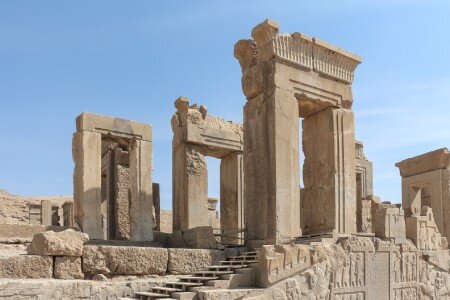Magnificent ruins and clues about Persian script evolution

TEHRAN– Apart from matchless royal arts and architecture, the UNESCO-designated Persepolis, which was once the ceremonial capital of the Achaemenid Empire (c. 550– 330 BC), holds treasured clues to the Persian writing and script as well.
For instance, Tachara Palace is among the reliable sources when it comes to the history of Persian writing. The gorgeous ruins bear noteworthy inscriptions and bas-relief carvings.
As mentioned by Mojtaba Doroodi, who is a specialist in historical linguistics, etymology and Iranian languages, the (modern) Persian language tightly follows Middle and Old Persian, which can be traced in the cuneiform writings of the Tachara Palace.
Doroodi believes that those bas-relief inscriptions are chiefly connected with Darius I (commonly known as Darius the Great), Xerxes and Artaxerxes.
Moreover, the palace has inscriptions written in Middle Persian or Pahlavi script, which date from the reign of Shapur II (Shapur the Great), the researcher said.
Persian, also called Farsi, belongs to the Iranian branch of the Indo-Iranian language family. Old Persian dates from around the 3rd century BC.
According to Britannica, Middle Persian, which was spoken from the 3rd century BC to the 9th century CE, can be traced in numerous epigraphic texts of Sasanian kings, written in Aramaic script; there is also varied literature in Middle Persian embracing both the Zoroastrian and the Manichaean religious traditions.
Pahlavi was the name of the official Middle Persian language of the Sassanian empire.
Persepolis website says that Tachara was built on a rectangular plan, measuring 40m by 30m, and a north-south axis. It consists of the main hall with twelve columns, two smaller columned halls on the north, a columned portico on the south, and several guardrooms or storage chambers on either side. A stairway with two reversed flights leads to the portico from a courtyard on the south. The inner walls of these flights are sculptured with representations of servants and attendants, dressed alternately in the «Median» and «Persian» costumes, carrying food and utensils.
In the center of the staircase, the facade is a carved frieze consisting of several scenes. At the top of the central part is a winged circle (Glory of Iran), flanked by two sphinxes facing each other, each raising a hand in reverence.
Behind each sphinx is a terrace with palm trees. Below this scene is two opposing rows of nine soldiers dressed in “Persian” attire (rich cylindrical turbans, skirts, and three-strap shoes). They contain Old Persian cuneiform inscriptions carved by Xerxes in a rectangular area surrounded by a band of rosettes.
The main hall and other rooms have rectangular niches, each carved from a single block and covered with vertically twisted archival elements known as Egyptian Cobetto cornices. Originally, five doors ran through the walls of the Great Hall. Two were four-columned north rooms. One had access to the south porch, and two led to the adjacent west and east rooms.
Persepolis, also known as Takht-e Jamshid, whose magnificent ruins rest at the foot of Kuh-e Rahmat (Mountain of Mercy) is situated 60 kilometers northeast of the city of Shiraz in Fars province. The city was burnt by Alexander the Great in 330 BC apparently as revenge against the Persians because it seems Xerxes had burnt the Greek city of Athens around 150 years earlier.
AM
Leave a Comment